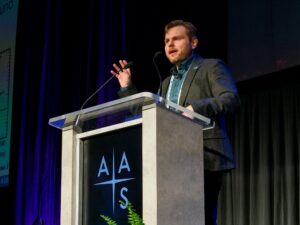Stephen Taylor appointed to NASA’s Laser Interferometer Space Antenna mission
 Albert Einstein’s general theory of relativity may soon be disproven by the Laser Interferometer Space Antenna (LISA), and Assistant Professor of Physics and Astronomy Stephen Taylor will be part of a selective team of scientists leading the effort.
Albert Einstein’s general theory of relativity may soon be disproven by the Laser Interferometer Space Antenna (LISA), and Assistant Professor of Physics and Astronomy Stephen Taylor will be part of a selective team of scientists leading the effort.
Taylor is one of only six scientists nationwide appointed to the LISA team, a joint mission between the European Space Agency and NASA. LISA is a space-based gravitational wave detector constructed of three spacecraft separated by millions of miles in a triangle shape as big as the sun.
The team will guide a collaboration of hundreds of people, connect with industry partners, and coordinate between NASA, ESA, and the academic community to ensure that LISA will be the premier space-based gravity telescope of the next decade. As part of the mission, LISA will fire laser beams between each spacecraft to form a triangle, orbiting around the sun to locate the position and identify the properties of different gravitational-wave sources.
“My role involves planning for how LISA will take the laser data from the satellites and perform what we call a ‘global fit’ on all of the signals from a huge number of potential sources,” Taylor said. “I’m grateful to my colleagues here at Vanderbilt who have worked on LISA, such as Jessie Runnoe, Karan Jani, Mallory Molina, and especially Kelly Holley-Bockelmann, who was the chair of the NASA LISA Study Team and has been a champion of LISA research for many years.”
The role will utilize Taylor’s expertise, which he has developed in part by working for more than 10 years with the North American Nanohertz Observatory for Gravitational Waves Physics Frontiers Center. Last year, Taylor announced NANOGrav’s discovery of a cosmic background hum of gravitational waves.

Taylor said LISA has the potential to break Einstein’s general theory of relativity, which holds that what we perceive as the force of gravity arises from the curvature of space and time. LISA may observe massive black holes around which a much smaller object orbits, acting like a beacon that signals back the shape of the fabric of space-time around the black hole. If the team sees some offsets from what Einstein predicted, they will have disproved his theory and may find hints of a deeper truth.
“LISA is still over ten years from being launched but was officially adopted as a mission by the European Space Agency earlier this year,” Taylor said. “The forward planning is a testament to the incredibly intricate, solar-system-spanning, gravity telescope that LISA is, and its immense promise as a window onto the gravitational wave landscape.”
